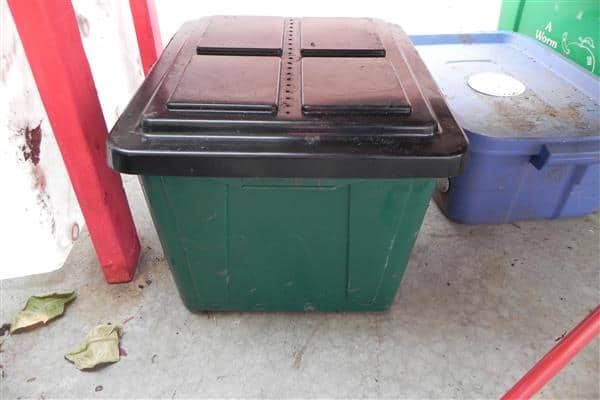
Recycle bins with ventilation are perfect for vermiculture
Yes, I admit it. After precisely 2 years of employment at Camp Kawartha, I finally have worms! I’ve had them all winter but didn’t realize it until a few days ago when I was alone in the greenhouse watering and weeding and thinking about giving the fish tank a good scrub. I happened to bend down and noticed what looked like a recycling bin beneath the counter but when I opened the lid there they were, buried up to their dewy little tubular bodies in their own castings (aka worm poo, or to put it more accurately, beautifully finished compost). A previous staff member had started this lovely colony in the Fall but as often happens with people working part time and seasonally, she moved on and no one was tasked with checking in on them. Thankfully, they had survived in the winter in the warm, moist darkness waiting for the day when the next meal would drop mysteriously from above.

Young, healthy red wriggler
After doing a bit of online reading, I learned that composting with worms is known as vermicomposting or vermiculture and no ordinary earthworm is up for this Olympian task of devouring kitchen scraps and garden waste. Suitable varieties include the red wriggler (Eisenia foetida or “manure worms”), red earth worms (Lumbricus rubellus), African Nightcrawlers (Eudrilus eugeniae) and Eisenia hortensis, known as “European night crawlers.” Despite the unfortunate handle, I love our red wrigglers, my respect compounded by the fact they remained unscathed after numerous hungry months in a 100 degree hothouse.

Takeout ready for delivery
Luckily, the worms already had the right environment – a dark, moist, warm, well ventilated container but they had run out of the vital “bedding” – sand, cardboard, peat moss. leaves, dried bark and the like – which provides them with grit to “chew” their food. Adding moisture is also important – the bedding should always feel like a damp sponge. The final step was to give them food to work their magic on. I solicited donations of appropriate scraps from the office staff – fruit peels, crushed eggshells, coffee grinds, tea bags, pretty much anything that doesn’t contain grease, protein or dairy.

Scraps and grit to be pressed into the compost
Through my research I learned that they like to have their food and bedding slightly buried so I pushed the items down into the moist muck and left them alone to do their important work. I will check back in a week and report on how these these toothless wonders are enjoying their first meal.. stay tuned!

